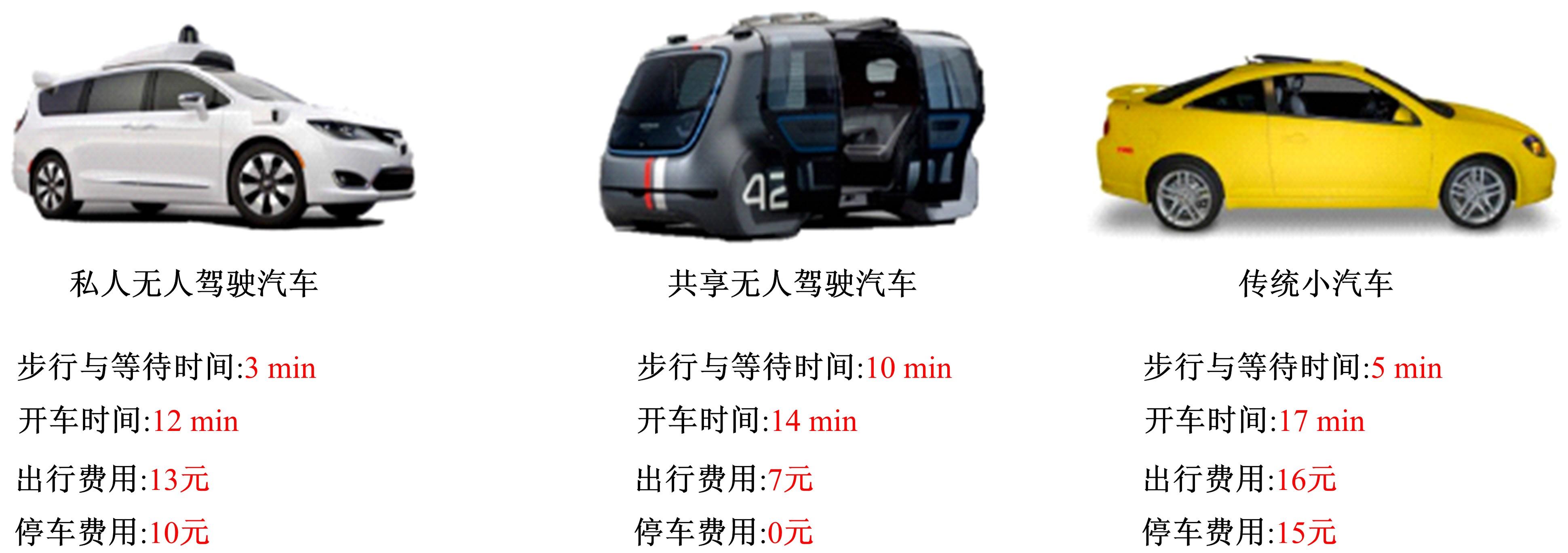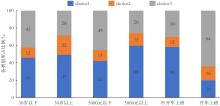吉林大学学报(工学版) ›› 2021, Vol. 51 ›› Issue (4): 1261-1268.doi: 10.13229/j.cnki.jdxbgxb20200390
• 交通运输工程·土木工程 • 上一篇
基于潜在类别的无人驾驶汽车选择行为
- 1.武汉轻工大学 土木工程与建筑学院,武汉 430023
2.华南理工大学 土木与交通学院,广州 510640
3.东南大学 交通学院,南京 210096
Travelers′ choice behavior of autonomous vehicles based on latent class
Zhi-wei LIU1( ),Jian-rong LIU2(
),Jian-rong LIU2( ),Wei DENG3
),Wei DENG3
- 1.School of Civil Engineering and Architecture,Wuhan Polytechnic University,Wuhan 430023,China
2.School of Civil Engineering and Transportation,South China University of Technology,Guangzhou 510640,China
3.School of Transportation,Southeast University,Nanjing 210096,China
摘要:
为了分析出行者出行选择偏好的异质性和无人驾驶汽车对出行选择行为的影响,基于扩展技术接受模型的理论框架,将心理潜变量纳入潜在类别条件Logit模型,建立混合选择模型进行实证研究。结果表明:相比传统的条件Logit模型,潜在类别条件Logit模型的拟合优度更高。受访出行者可以分为共享无人驾驶汽车偏好群体、小汽车偏好群体和私人无人驾驶汽车偏好群体,3个潜在类别分别占比为46.5%、13.0%和40.5%。小汽车偏好群体对步行与等待时间和出行费用持正向评价,私人无人驾驶汽车偏好群体对停车费用持负面评价。感知易用性和感知信任两个潜变量对出行者潜在类别划分具有显著影响。
中图分类号:
- U121
| 1 | Molin E, Mokhtarian P, Kroesen M. Multimodal travel groups and attitudes: a latent class cluster analysis of Dutch travelers[J]. Transportation Research Part A: Policy and Practice, 2016, 83(1): 14-29. |
| 2 | Zhang X, Guan H, Zhu H, et al. Analysis of travel mode choice behavior considering the indifference threshold[J]. Sustainability, 2019, 11(19): 1-23. |
| 3 | Boxall P C, Adamowicz W L. Understanding heterogeneous preferences in random utility models: a latent class approach[J]. Environmental and resource economics,2002, 23(4): 421-446. |
| 4 | Sarrias M, Daziano R. Multinomial Logit models with continuous and discrete individual heterogeneity in R: the GMNL package[J]. Journal of Statistical Software,2017, 79(2): 1-46. |
| 5 | Ardeshiri A, Vij A. Lifestyles, residential location, and transport mode use: a hierarchical latent class choice model[J]. Transportation Research Part A: Policy and Practice,2019, 126(10): 342-359. |
| 6 | 刘建荣,刘志伟. 基于出行者潜在类别的公交出行行为研究[J]. 华南理工大学学报:自然科学版, 2019, 47(6):119-126. |
| Liu Jian-rong, Liu Zhi-wei. Analysis of bus users' behavior based on latent class[J]. Journal of South China University of Technology (Natural Science Edition), 2019, 47(6): 119-126. | |
| 7 | Ben-Akiva M, Mcfadden D, Gärling T, et al. Extended framework for modeling choice behavior[J]. Marketing Letters, 1999, 10(3): 187-203. |
| 8 | 景鹏,隽志才,查奇芬. 考虑心理潜变量的出行方式选择行为模型[J]. 中国公路学报, 2014, 27(11): 84-92, 108. |
| Jing Peng, Zhi-cai Juan, Zha Qi-fen. Incorporating psychological latent variables into travel mode choice model[J]. China Journal of Highway Transportation, 2014, 27(11): 84-92, 108. | |
| 9 | Davis F D, Bagozzi R P, Warshaw P R. User acceptance of computer technology: a comparison of two theoretical models[J]. Management science, 1989, 35(8): 982-1003. |
| 10 | Venkatesh V, Davis F D. A model of the antecedents of perceived ease of use: development and test[J]. Decision Sciences, 1996, 27(3): 451-481. |
| 11 | Mou J, Shin D, Cohen J F. Trust and risk in consumer acceptance of e-services[J]. Electronic Commerce Research, 2016,16(1):141. |
| 12 | Bansal P, Kockelman K M, Singh A. Assessing public opinions of and interest in new vehicle technologies: an Austin perspective[J]. Transportation Research Part C: Emerging Technologies, 2016, 67(6): 1-14. |
| 13 | Train K E. EM algorithms for nonparametric estimation of mixing distributions[J]. Journal of Choice Modelling, 2008, 1(1): 40-69. |
| 14 | Pacifico D, Yoo H I. Lclogit: a Stata command for fitting latent-class conditional Logit models via the expectation-maximization algorithm[J]. The Stata Journal, 2013, 13(3): 625-639. |
| 15 | Panagiotopoulos I, Dimitrakopoulos G. An empirical investigation on consumers' intentions towards autonomous driving[J]. Transportation Research Part C: Emerging Technologies, 2018, 95(10): 773-784. |
| 16 | Yáñez M F, Raveau S, Ortúzar J D D. Inclusion of latent variables in mixed Logit models: modelling and forecasting[J]. Transportation Research Part A: Policy and Practice,2010, 44(9): 744-753. |
| 17 | Wang J, Wang X. Structural Equation Modeling: Applications Using Mplus[M]. Chichester: John Wiley & Sons, 2012. |
| [1] | 查伟雄,蔡其燕,李剑,严利鑫. 边路车辆出入条件下城市干线信号协调相位差优化[J]. 吉林大学学报(工学版), 2021, 51(2): 565-574. |
| [2] | 栾鑫, 邓卫, 程琳, 陈新元. 特大城市居民出行方式选择行为的混合Logit模型[J]. 吉林大学学报(工学版), 2018, 48(4): 1029-1036. |
| [3] | 孙轶轩, 邵春福, 岳昊, 朱亮. 基于SVM灵敏度的城市交通事故严重程度影响因素分析[J]. 吉林大学学报(工学版), 2014, 44(5): 1315-1320. |
| [4] | 董宏辉,孙晓亮,贾利民,秦勇. 多模态的交通流量预测模型[J]. 吉林大学学报(工学版), 2011, 41(03): 645-649. |
| [5] | 姜桂艳,吴超腾. 基于GPS采集车辆行程时间的路段划分模型[J]. 吉林大学学报(工学版), 2009, 39(增刊2): 177-0181. |
| [6] | 吕能超,严新平,RanBin,徐堃. 基于道路出行者行为的大型活动停车模型[J]. 吉林大学学报(工学版), 2009, 39(增刊2): 135-0139. |
| [7] | 宋现敏,王殿海,金盛. 感应式协调控制下绿信比优化方法[J]. 吉林大学学报(工学版), 2009, 39(增刊2): 154-0157. |
| [8] | 王殿海,孙锋,金盛 . 两相位交叉口左转车通行能力计算方法[J]. 吉林大学学报(工学版), 2007, 37(04): 767-771. |
| [9] | 李洪萍,裴玉龙,杨中良 . 快速路自由流速度及其影响因素 [J]. 吉林大学学报(工学版), 2007, 37(04): 772-776. |
| [10] | 姜桂艳,郑祖舵,白竹,代磊磊,赵佳琪. 拥挤条件下可变信息板交通诱导信息对驾驶行为的影响[J]. 吉林大学学报(工学版), 2006, 36(02): 183-0187. |
|
||



